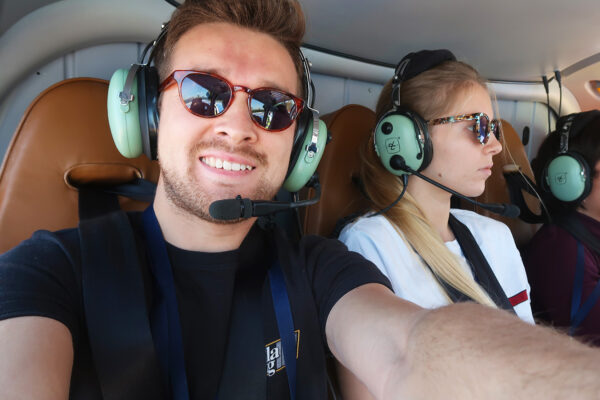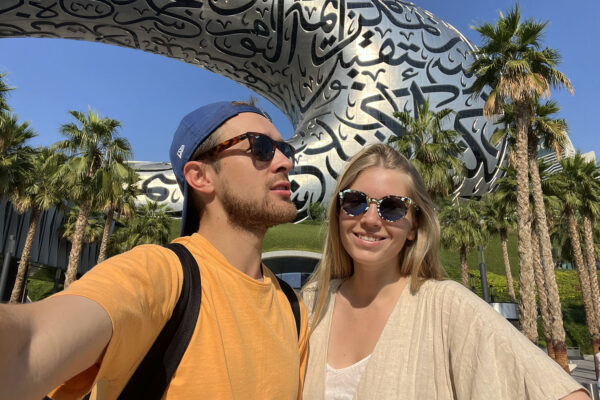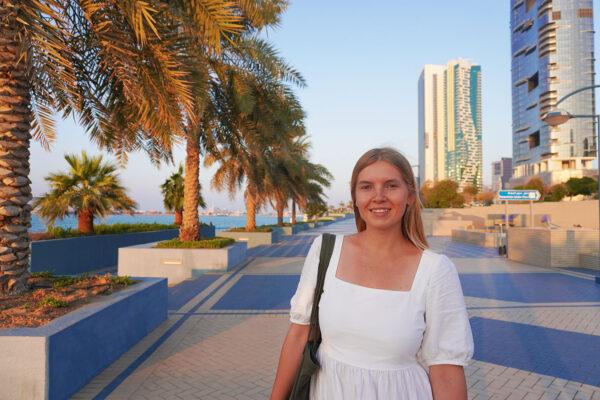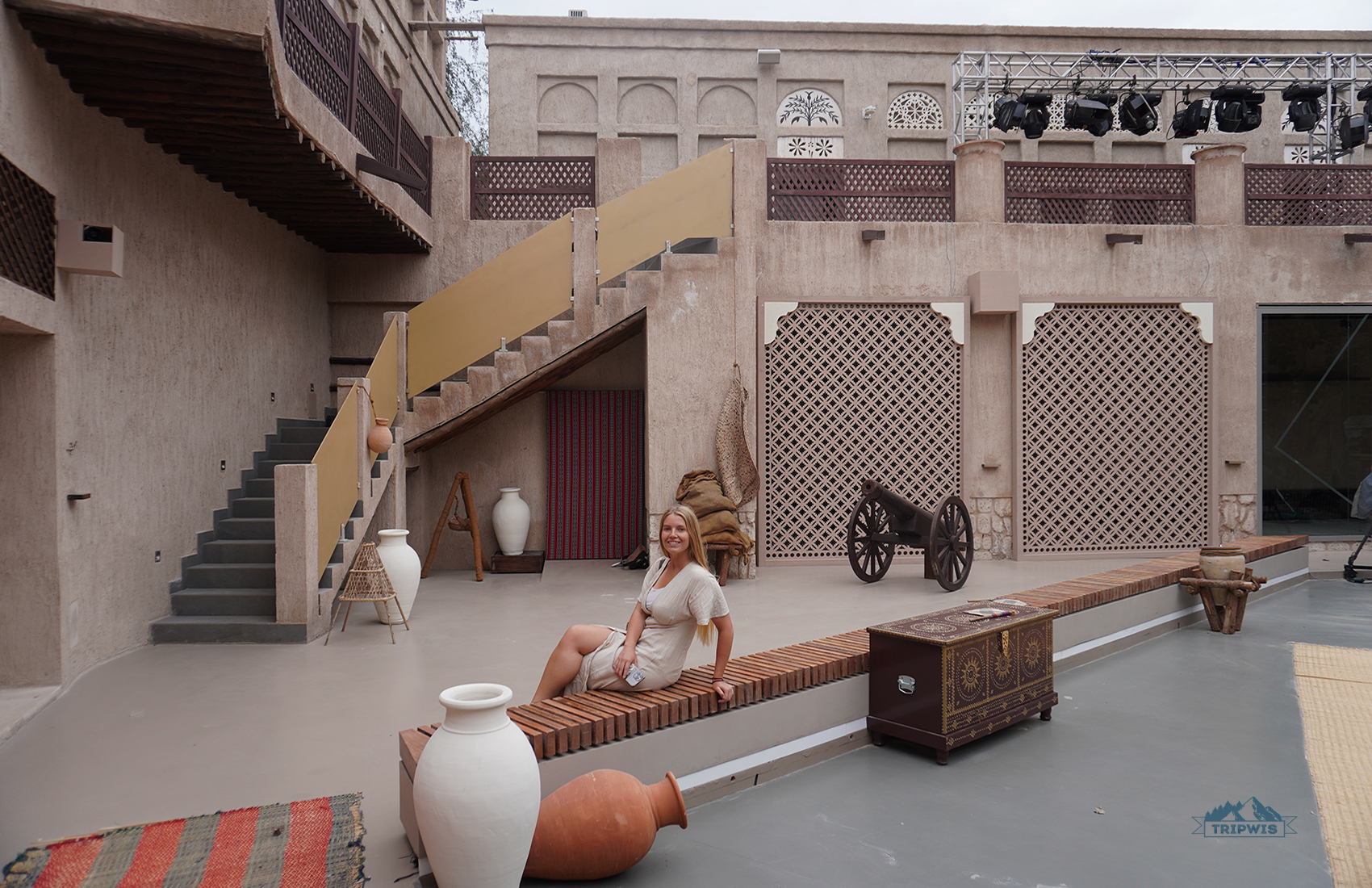
While the modern part of Dubai is pretty in-your-face from the second you enter the city limits, you have to put in a little work to find the spots that have stayed true to history of the once small fishing village on the banks of Persian Gulf.
We scoured the ground in search of the place that best preserved the sense of the old city and came up with a winner: a recently opened Al Shindagha Museum in Dubai, United Arab Emirates. This museum, located in the historical district of Al Fahidi, will challenge the way you think about Dubai.
Article contents
- What is so special about Al Shindagha Museum in Dubai?
- Timings and entrance fee
- What is shown in Al Shindagha Museum?
- Things to do near the museum
- How to get to Al Shindagha?
- Which museums in Dubai do we recommend?
What is so special about Al Shindagha museum in Dubai?

Al Shindagha Museum, the largest heritage museum in the UAE, is part of a bigger historical conservation efforts of the city: Dubai’s Heritage Village. The name of the museum stems from the name of the neighborhood it calls home: Al Shindagha.
The actual word Shindagha has had a more complicated journey: They say that it’s not inherently Arabic, but it loosely means mouth, hinting at the neighborhood’s location at the mouth of the Dubai Creek.
- The neighborhood, together with the museum, has one important mission to follow: Connecting Emirati’s past with its present.
A large open-air museum lets you catch a glimpse of the traditional lives of local people throughout the city’s rapid development. The exhibitions exercise all of your senses, not stopping on the usual visual and audio components. For example, the Food and Perfume Houses break these standard museum barriers.
We love the Al Shindagha museum for its amazing atmosphere. As you walk through the narrow alleyways, looking at the sandstone walls and watchtowers, it’s like you travel back in time — long before skyscrapers started filling up Dubai’s airspace.
Is it worth going to Al Shindagha museum?

In our humble opinion, Al Shindagha museum is a worthy stop on your Dubai itinerary. It’s a good change of pace, after your eyes can’t take any more record-breaking sights of the tallest building in the world, the biggest Ferris wheel (temporarily closed, soon to be reopened; still, a marvelous sight in and of itself), etc, etc… The low historical buildings of the museum provide a whole another appeal, more muted, perfect for quiet contemplation.
Rich cultural heritage of the region will pull you in and not let you leave until you’ve seen, heard, and experienced everything. Depending on your pace, leave around two to three hours to explore the majority of exhibitions. If you plan on attending workshops, throw another couple of hours into the mix.
We hope that our descriptions of the spaces will help you create your own itinerary of things to see in Al Shindagha museum. But if you prefer to have a knowledgeable person walk you through the houses, then we recommend booking one of the guided tours provided by the museum.
Al Shindagha museum timings
Al Shindagha museum is open daily, from 10 a.m. to 8 p.m.; last entry is at 7 p.m.
During the Holy month of Ramadan, the timings change a little: The museum is still open daily, but the opening hours are from 10 a.m. to 5 p.m.; last entry is at 4 p.m.
To stay up-to-date with any changes that might affect the opening hours, follow the museum’s Instagram @alshindaghamuseum. Come for the information, stay for the wonderfully curated feed and mesmerizing posts!
How much is the entrance fee for Al Shindagha museum?
How much is the entrance fee for Al Shindagha museum? Depending on your status (be it part of a group, solo, or if you’re the lucky handsome student-aged fella), Al Shindagha museum’s tickets price varies a little:
| Adult Ticket | 50 AED ($13,60) |
| Student Ticket | 20 AED ($5,45) |
| Group Ticket (5+ people) | 40 AED ($10,90) |
It is free for children under the age of five and senior Emiratis.
The booking policy can be found on the official booking website, which is pretty easy to use: Select Al Shindagha museum, the date of your planned visit, the number of tickets and you’re almost there. After filling out your personal info and paying, you receive a digital ticket right in your inbox. Groovy, huh?
What is shown in Al Shindagha museum in Dubai?

What is shown in Al Shindagha museum in Dubai? There’s no short answer, really, since the museum covers A LOT OF different topics all under the dome of life in Dubai: Both past and present.
Spanning across a large chunk of land, the museum boasts 22 pavilions and around 80 historical houses. Newly renovated and inaugurated in early March of 2023, the premises call for new visitors to explore their plentiful exhibitions.
Here are the main parts that are worth looking into during your visit:
- Al Maktoum Residence

The first exhibition space on our list is one of the most important ones. It lets you learn more about the driving force that made Dubai a modern sprawling megapolis it is today. How does is the permanent collection of the Al Maktoum family get into the picture? Well, this family and its ambitions for the Emirate are the only reasons the city got so successful so fast.
The highlights: You walk inside the actual former family home and learn more about the wise choices of Dubai’s rulers that first made the city an important Trade Hub, and later the center for innovation and grandeur.
The house has a big courtyard to walk around in and a rich history: From being a literal home to the ruling family, to then falling into a complete disrepair, only to get reconstructed into the museum.
- Emerging City

One of our favorite exhibitions in Al Shindagha museum! It is here where you can trace the sometimes non-linear development of the city from its humble beginnings as a small fishing village that used every opportunity (pearls, trade, and oil) to fund its ever-growing potential.
You can also learn more about the city’s old architecture through the various miniatures of traditional buildings, as well as exhibitions detailing the ways architects learned to take control of the harsh weather.
The highlights: There are so many fascinating tidbits of information you can find here. Like the start of Dubai Television and the Channel 33 that first broadcasted in English (!) to cater to the international expats living in Dubai. Or the ways the locals lived in the constantly growing communities (the hubs of life were the alleyways, also known as sikeek).
- Culture of the Sea
Dubai’s location makes its development to be closely interwoven with water: The Gulf and Dubai Creek have long been considered to be the city’s getaways to other global cultures. Thus, the rich maritime history of Dubai is an essential topic for discussion. This exhibit does a good job of telling the story through the lives of Emirati people most connected to the sea: Fishermen, merchants, pearl divers, shipbuilders, and the like.
The highlights: You are met with all the blue as you enter the exhibit. It’s a nice contrast to the mainly sand colored museum’s premises. As you walk through the dimly lit hall, the state-of-the-art installations let you dive in deeper (no pun intended) into Dubai’s close relationship with the sea.
- People and Faith
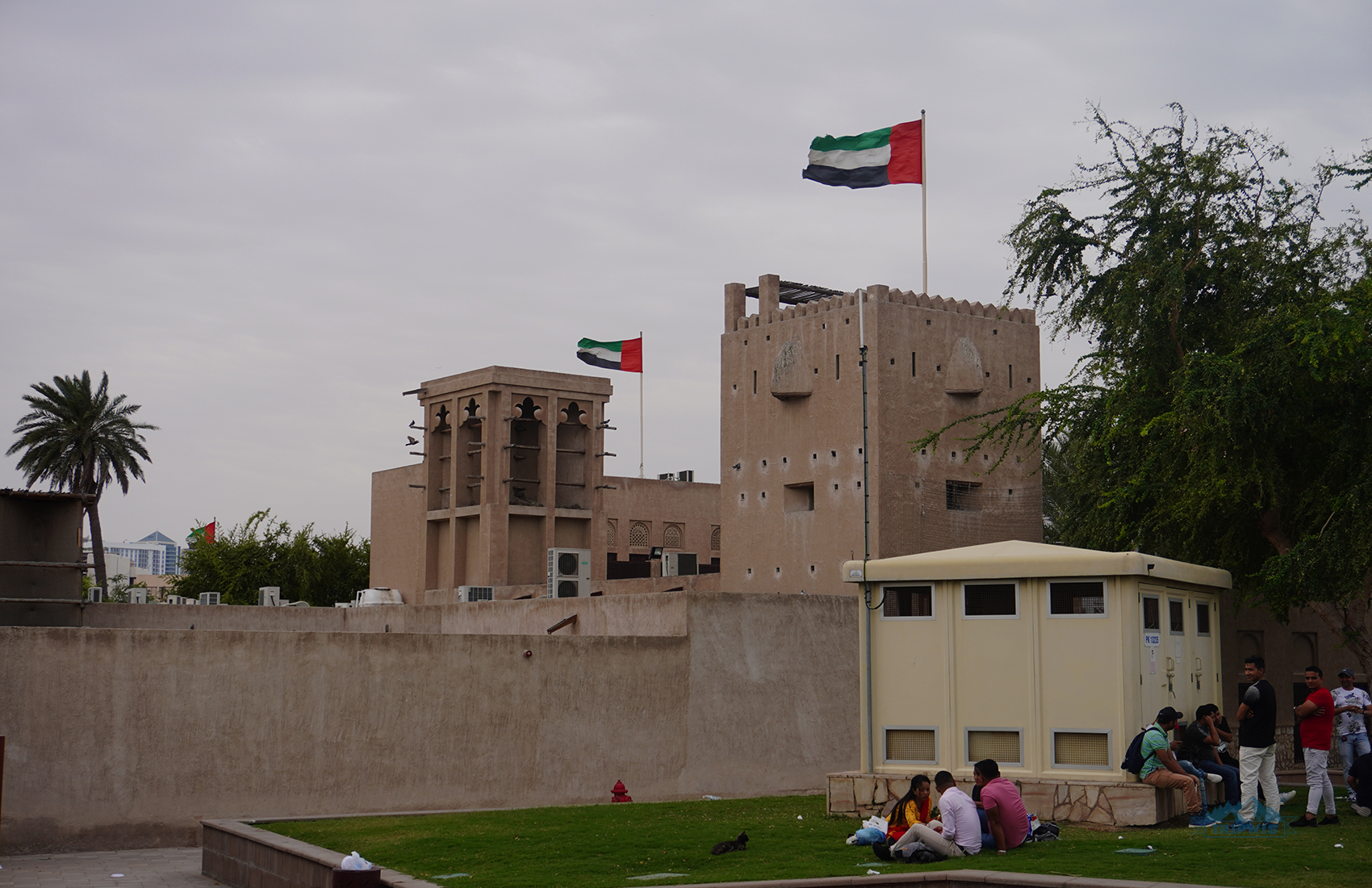
The only thing that remains the same in the rapidly developing megapolis is religion that links Dubai’s past to its present. We’re sure that the best way to learn about any of the world’s communities is through religion that the majority of the population subscribes to.
The highlights: Learning more about the ritual of haji — a Muslim’s pilgrimage to Mecca, and all the things that went into preparing a traveler for their journey. A unique sensory experience, this exhibition creates a welcoming ground for you to take a peek into the religion of Islam.
- Beauty and Adornment
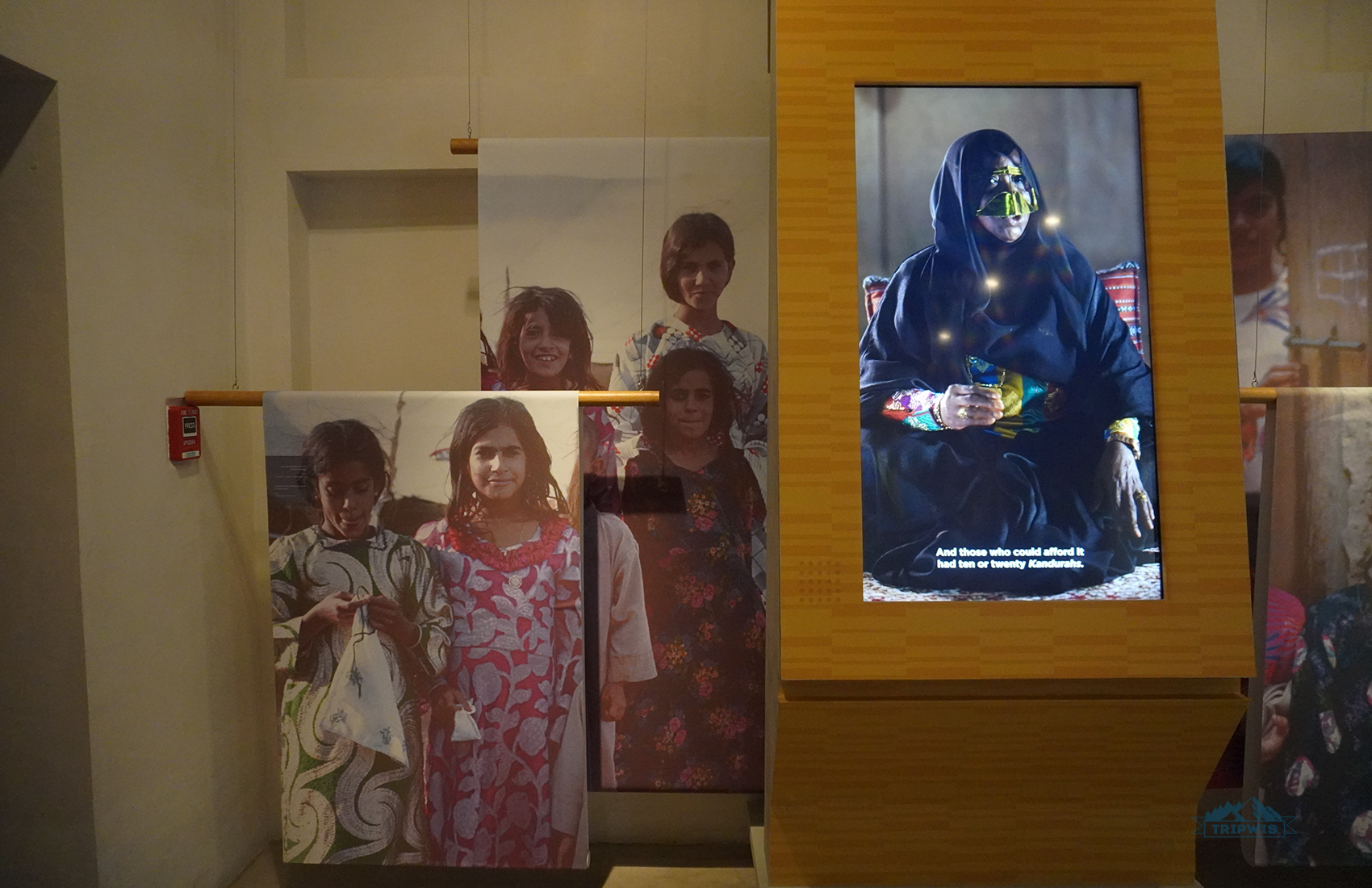
This part of Al Shindagha museum is dedicated to all things beauty and clothing. The collection is set inside a low-ceiling cave-like structure that would otherwise feel very claustrophobic if not for the warm light fixtures and a fair share of natural light making its way through the windows. What exactly is shown here? Anything from traditional fabrics to men’s and women’s national clothing.
The highlights: The most memorable parts for us were the installation for the iconic burqa (a face covering worn by women) and its history, and the interesting description of the henna night — the night before the wedding, when the bride is adorned with jewelry and henna drawings on her arms and feet.
- Traditional Crafts
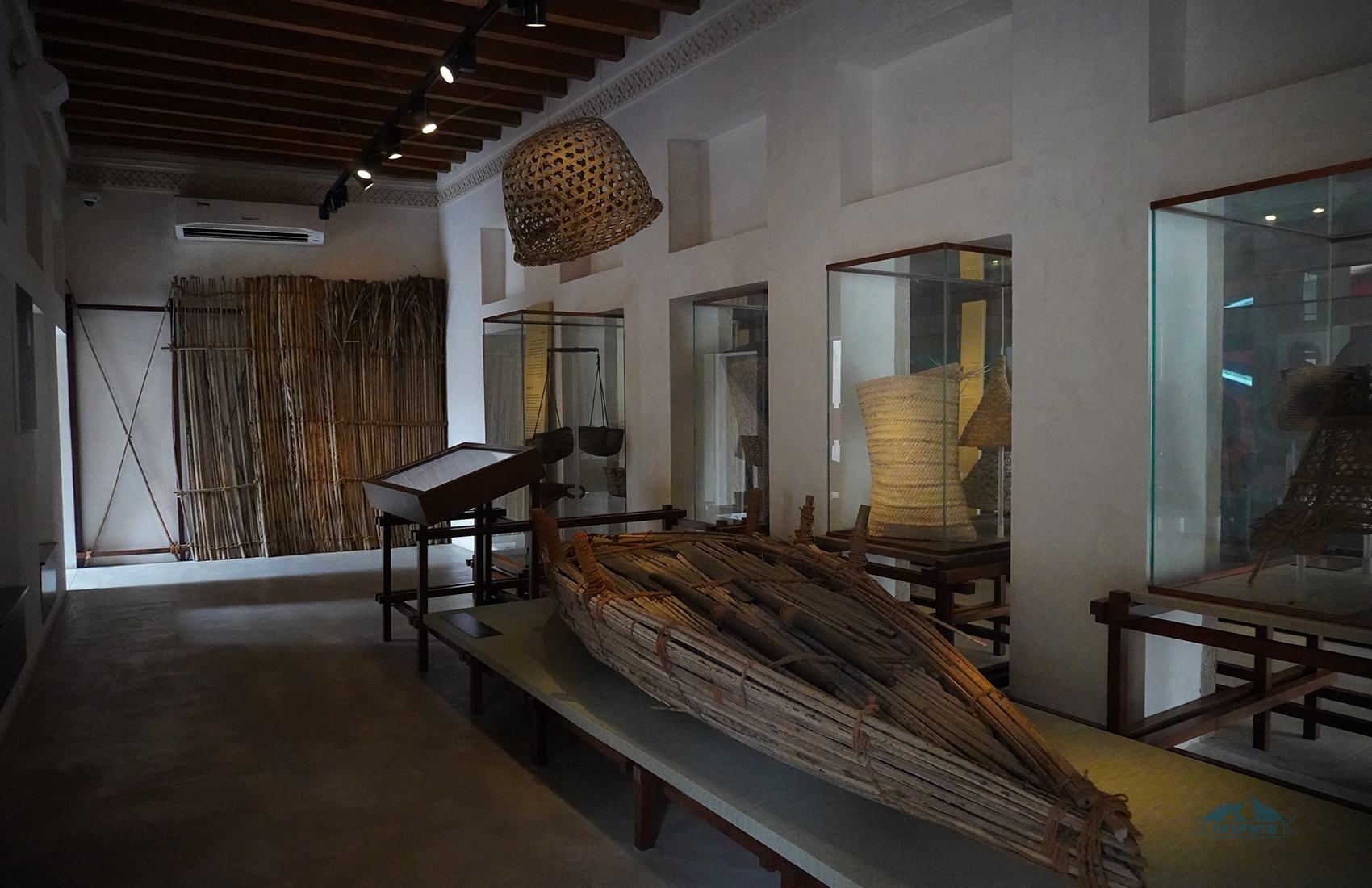
On the more colorful side of the museum’s installations, the part that tells the tale of local crafts is the ultimate tourist destination. Do you want to see the recreations that adorned the daily life of Dubai communities? You’ve come to the right place!
The highlights: Pottery, woodworking, metalworking — all of the usual crafts are shown here, along with the tools and materials used in the processes. Displayed objects of Emirati craftsmanship will leave you in disbelief of the period when they were created: The quality and attention to details is on par with items being made in our time!
This exhibition will take you awhile to get through, as every little corner is filled with attention-grabbing things. A simple walkthrough is unlikely to be on the menu, there’s too much exciting stuff to learn.
- Traditional Food House
A short stroll from the Culture of the Sea (with an amazing view out on the Creek), you are guaranteed to stumble upon the Traditional Food exhibit. Now, we hope you aren’t hungry, because you will be bombarded with mouthwatering pictures of food from the get-go!
The highlights: The wonderful rules of Dubai hospitality, from serving coffee and dates to the guests upon their arrival, to giving them a farewell present of incense; the way locals traditionally set the table and explore the practices surrounding food in Dubai.
Note the information on the popular spices, like saffron, cardamom, and cinnamon, and make sure to buy some for yourself when you head to the souq (or souk, meaning street market) later on during your trip.
- Traditional Healthcare
 |
 |
A part of the museum with seemingly the greenest courtyard, the Traditional Healthcare House focuses on keeping the knowledge of Dubai traditional healers alive, as well as highlighting the current initiatives intended to make the city the center for world-class medical practices.
The highlights: You will be surprised to learn that the candle’s smell of frankincense (also known as luban in these parts) has long been used to naturally treat respiratory and digestive diseases.
- Traditional Jewelry
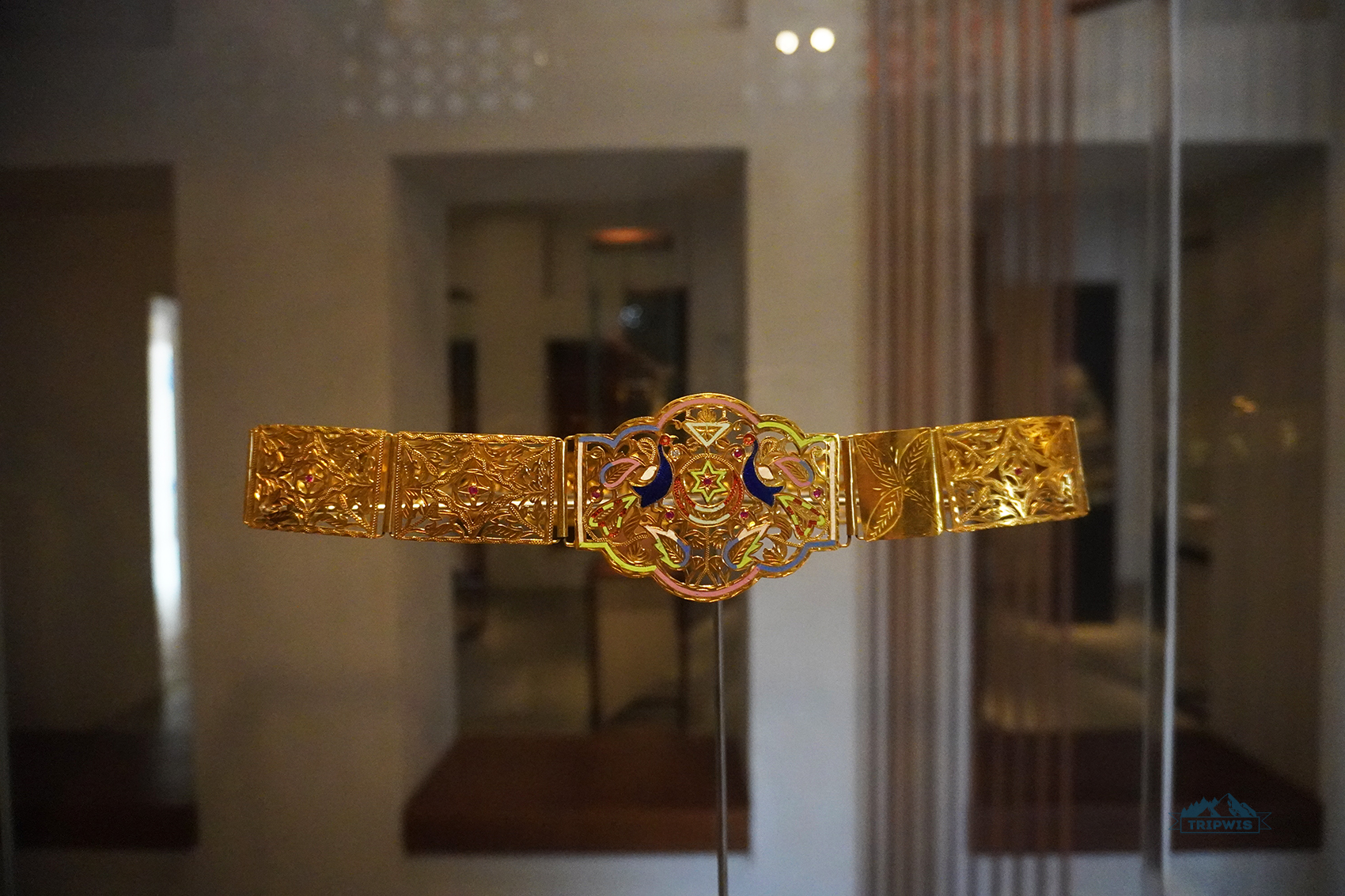
We encourage everyone not to miss this part of the museum. You will see that not only Emirati women adorned themselves with jewels: The men had a lot of traditional pieces worn for special occasions, which will be fun to learn about.
As your eyes get used to all the gold shine, and you stop being impressed with the sheer size of, say, the precious metal earrings, it’s time to move on to another part of the museum.
The highlights: It’s the most amount of gold you’ve ever seen in your life (well, at least until your Gold Souk expedition). If you feel like you can take no more of shine and glitz, let’s head over to museum’s most famous exhibit — the Perfume House.
- Perfume House

The ultimate tourist attraction of the museum, the Perfume House exhibition will take your senses on an enticing journey of Arabic perfume-making and its most commonly used ingredients, tools, traditions, and chemistry behind every scent.
The highlights: The exhibition is a proud owner of a huge piece of oud that weighs almost 30 (!) kilograms and looks like a Tim Burton take on a tree trunk.
Make sure your sniffers are ready to get to know the local scent combinations, while learning more about ancestral practices of perfume making. We especially enjoyed a video demonstration of a coveted ancient recipe for making a traditional Emirati powdered perfume. Imagine cardamom, cloves, saffron, rose buds, white musk, and other ingredients carefully combined to create a wonderfully aromatic powder, paired with nicely animated instructions.
The use of scents in traditional and religious practices in Dubai is a topic of endless exploration, but doesn’t take too long, as there are plenty more houses of the museum to investigate.
- Life on Land
Here you will find out more about the harsh realities of living in Dubai. In other words, the way sand dunes, Dubai Creek, and mountains influence the local way of life.
The highlights: There’s so many interesting ways Dubai residents interact with their surroundings! It’s fun to learn how trackers decipher the signs left in constantly shifting sand dunes, and what messages from the past are left in the area’s mountainous parts.
The artwork supporting the ideas is simply wonderful, giving off “modern minimalist house design,” if you look at the wooden sand dunes replicas as some sort of Kim Kardashian-esque furniture. Anyway, the exhibition is pretty engaging and informative, no matter from which point of view you’re coming from.
- Life on Land: Expressions
It would be foolish to imagine that Dubai landscape doesn’t find its way into local lore: After all, oral traditions have long preceded the written word, and traversing around the desert leaves a lot of time for songs, poetry, and storytelling.
The highlights: Hear the sung poetry of pearl divers, take your hand at playing one of the locally cherished music instruments, witness traditional folk performances (on screen, but still very engaging), look at the incredibly sweet installation of folk tales, and dive into the world of community traditions (from the most commonly used proverbs to the rules of Dubai children’s games and the regalia needed for regional celebrations).
This part of the museum, in our opinion, is the most all-encompassing experience you can get here. Your eyes, ears, mind, and soul will be one hundred percent pleased with the time spent inside the exhibition!
- Life on Land: Water and Flora&Fauna
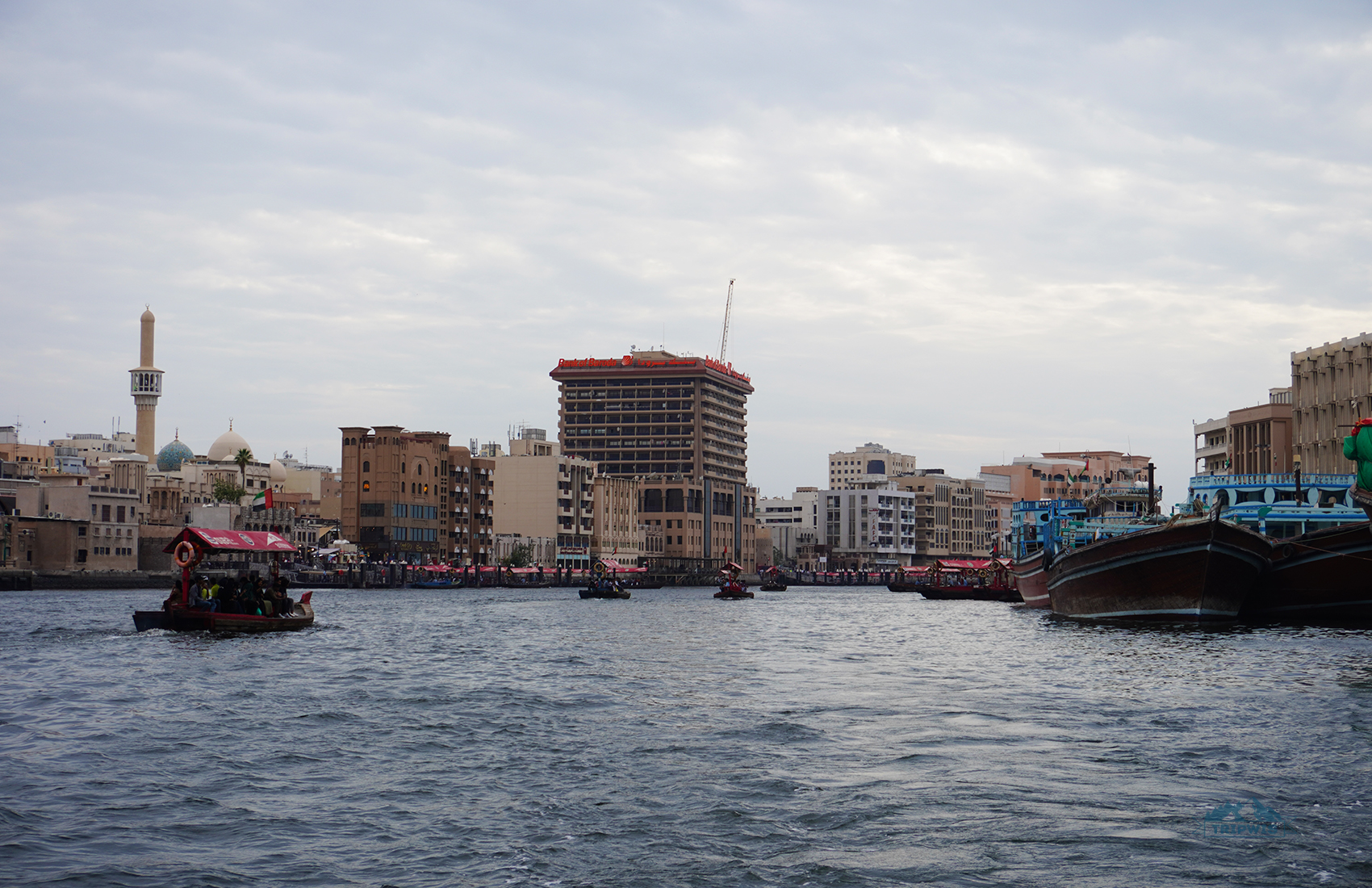
The exhibition opens up with an ode to water — truly the main part of Dubai’s communities’ survival and following success. Here you will learn the ways past residents located potential sweet (what they called drinkable water) water sources: Wells, springs, and the like. See the tools used for extraction, transportation, and storing of water; and gain a new appreciation for the way we live now, with running water being at our service with a turn of a nub.
Kids will be stocked to wander around the next part of the exhibit, as it showcases the beautiful (and very beige) specimen of both wild and domesticated animals.
The highlights: Look out for the cute desert hedgehog and indulge in the knowledge of the popular UAE pastime — falconry.
Did you know that dates grow on palms? We didn’t, so the next exhibit of Dubai’s native flora gave us a lot of insights into the plants of the region. The information on the successful crop cultivation was also uniquely engrossing, but strictly adult-oriented (you can leave your kids to hang out with the animal statues and explore this part solo).
- Life on Land: Trade and Journeys
Ending your museum visit virtually on the same topic we’ve started on, you come back to the question of trade in Dubai and how the city became a successful trade hub virtually from the start.
For people knowledgeable on the topic of taxes, it would be useful to learn about the Dubai tax exemption for foreign merchants and the consequent overflow of traders flocking to the area.
The highlights: The description of journeys undertaken by the locals of that time — what went into preparation (food-wise and general packing-wise), what were the dangers, what routes were generally used, and how the ordinary folk managed to survive the arduous travel.
To make learning new things more fun and interactive, the museum hosts regular themed workshops that you can easily take part in. Things to do in Al Shindagha Museum include family walking trails, jewelry making at the Traditional Jewelry House, perfume making at, you guessed it, the Perfume House, and traditional coffee experience (that’s more our scene) at the Traditional Food House. Pick what floats your boat the most to make the time you spend at the museum as unforgettable as it was for us!
Things to do near Al Shindagha museum

If you still got time after your museum visit, there are plenty more other unique things to check out in the area and beyond:
- Al Fahidi Historical District — as you leave the museum, don’t abandon the area right away: Walk around a little longer, as the district is home to many more carefully restored historical houses. Plus, the neighborhood is completely free to visit. Make use of the opportunity, and don’t forget to stroll along the Creek.
- Al Ustad Special Kebab — best kebab place in Dubai; the taste is on par with that of the authentic Middle Eastern dish. Get their kebab platter to taste all of the possible variations of flavors, you will not be disappointed!
- Take the ferry from Al Ghubaiba to Dubai Marina (with a stop at Dubai Water Canal and Bluewaters) for 50 AED ($13,60).
- Test your haggling skills at the nearest souks: Bur Dubai Souk Market — one-stop-shop for every possible souvenir you might want to bring from your trip. Traditional clothing, perfumes, spices, jewelry, and other small trinkets. This waterfront market place is a great spot to start practicing haggling, before taking a metro ride to more serious markets: Dubai Spice Souk and Dubai Gold Souk. Remember everything you’ve learned during your visit to the museum and try not to leave your whole budget here! If going into the busy market alone scares the bejesus out of you, then plan to be a part of a guided tour, like this one: Dubai Aladdin Tour, where you’ll definitely get help from your trusted guide!
- Al Seef — a beautiful waterfront promenade, stretching along almost two whole kilometers of Dubai Creek. Here, you can admire the traditional architecture, buy trinkets at another local souk, and dine in the many wonderful restaurants with a view on the water.
- Al Mamzar Beach — steering a little bit (or a lottle bit..why isn’t it a word?) off course, our recommendations finally take you somewhere you can relax on the sand. Al Mamzar Beach is under an hour bus ride away from the area of Al Shindagha museum, but we simply couldn’t recommend this place enough. It has everything: A huge green park, plenty of beach space, and lots of amenities one might need for a nice family outing (barbeque spots, playgrounds, swimming pools, etc.). Park entry is 5 AED ($1,5) per person.
- As we go further and further off track, no trip to Dubai is complete without having a kick-ass safari experience! Book yourself a tour beforehand (like this one) for a guaranteed adventure in Dubai’s sand dunes!
The spots in the general area surrounding the star of this article — Al Shindagha museum — can be found on the map, for easy navigation.
Important information
Getting to the museum is the first hurdle you encounter when planning your itinerary for the day. Thankfully, public transport in Dubai is greatly developed and super easy to navigate.
If the knowledge bug got to you and you want to continue exploring other Dubai’s museums, keep your eyes peeled for our personal suggestions!
How to get to Al Shindagha museum?

Bookended by Port Rashid on one side and Al Fahidi district on the other, the home of the museum — the neighborhood of Al Shindagha (traditional center of Dubai) — is pretty easy to find. The official museum website proves to be the top destination to find answers to all of your burning frequently asked questions. Consult with the website if we have failed to provide the info you were looking for.
Which metro station is near to Al Shindagha museum? — the Ghubaiba Metro Station is a short two-minute walk from the museum.
Which bus station is near to Al Shindagha museum? — the Al Ghubaiba Metro bus station is the nearest to the museum.
Which ferry station is near to Al Shindagha museum? — Al Ghubaiba Marine Transport Station 1 is a two-minute walk from the museum.
If you’re traveling by car, there’s ample public parking space along the adjacent Al Khaleej Street. You can also use the Shindagha City Centre Parking, which is also not too far from the entrance.
Al Shindagha museum’s Address is 288 – Dubai – United Arab Emirates; or you can simply use Google Maps to plan your route.
Which museums in Dubai do we recommend?

We hope that our detailed description of the things you can see in Al Shindagha museum made you realize that museums in Dubai are nothing like you’d ever imagined these spaces to be. They are fun, interactive, and widely captivating.
Of course, this museum has earned its spot at the top of our list of the best museums in Dubai, due to the sheer scope of the themes covered and the variety of ways they are presented.
As for other places in the city where you can nerd out on any particular topic, we have a few more in mind:
- Museum of the Future — one of the world’s greatest architectural masterpieces! Museum’s exterior is on par (if not more spectacular) with the exhibitions inside. Imagine you’re in the year 2071 and space exploration has made major leaps of breakthroughs: You can even get to space in a simulation (that looks and feels like an elevator ride, but we digress)! Then get back to Earth and explore other cool things exhibited in the spaces: Robotic marine animals floating in the air, the heal institute with tiny specimens levitating inside colorful tubes, a prototype of a flying car, and a huge safe space to disconnect from technology. There’s also an amazing viewing platform outside, where you can see the intricate design of the museum up close and personal, as well as enjoy the surrounding panoramas. Entry ticket to the museum is 149 AED ($40) per adult.
- Alserkal Avenue — a space that is pretty hard to define: It’s a former industrial area in the center of Dubai, which has now become a hub for all things creative. Galleries, pop-ups, design spaces, creative businesses — all of these things are contained to their own personal areas inside the venue. Our go-to choices here are Leila Heller Gallery and Pekoe tea&bread bar. The best thing is that the Avenue is free to enter, unless specified otherwise: If you’re taking part in a workshop or a festival, you might need to purchase a ticket.
- Museum of Illusions — a great place for a family outing, kids will be stocked to play with the confusing visions. Museum of Illusions will fill up your camera roll with at least a hundred pics per illusion, that’s a guarantee! Entry fee is $25,5 (about 93 AED) per adult.

- Coffee Museum — the ultimate destination among the narrow alleyways of Al Fahidi for anybody who lives and breathes coffee. While the museum is quite small and difficult to find, the complimentary Arabic coffee and dates you get upon entering make all the troubles worth it. The smell of good coffee will linger on your clothes for hours, and the heaps of information on each step of the brewing process will have your brain going for quite some time after the visit (or maybe it’s the caffeine). The entry fee is 10 AED ($2,7) per person.
- Louvre Abu Dhabi — okay, we admit, we wanted a reason to include this absolute cultural mammoth of the museum on our list, even though it’s located in Abu Dhabi. Still, this place alone is worth a detour: The masterpieces exhibited inside create a wonderful timeline of the human connection to art from prehistoric times all the way to contemporary period. Like its French cousin, UAE’s Louvre has an impressive collection of works by great artists that you don’t want to miss! General admission is 65 AED ($17) per adult.

Overall, we will remember Dubai for its rich historical heritage. We hope that we managed to show you the best course of action for when you’re about to tackle the history of the area. Al Shindagha museum has instantaneously become one of our favorite places in the city, and our biggest wish is for you to include this spot on your itinerary of places to visit in Dubai. If you have any further questions, leave them in the comments below!
